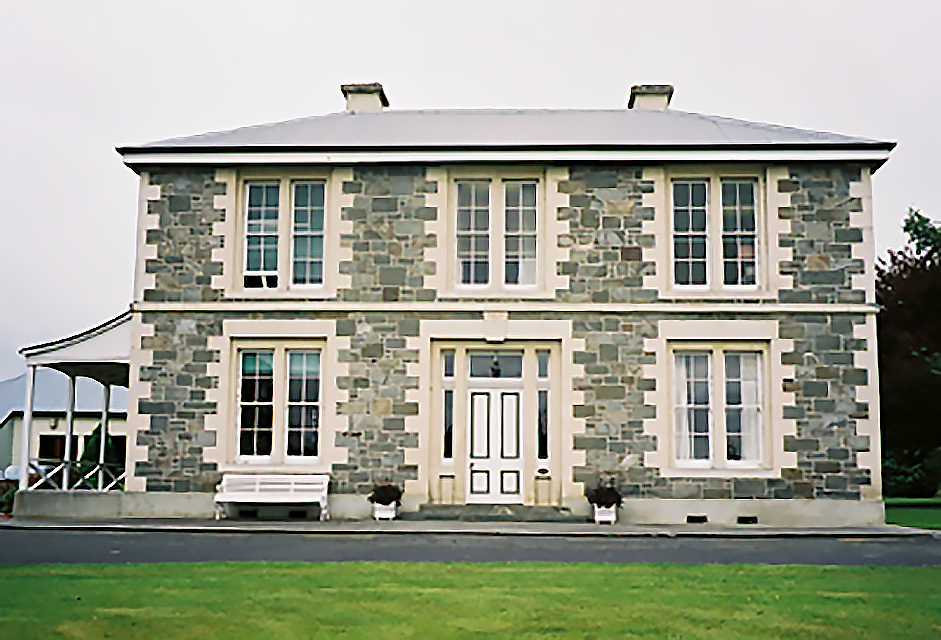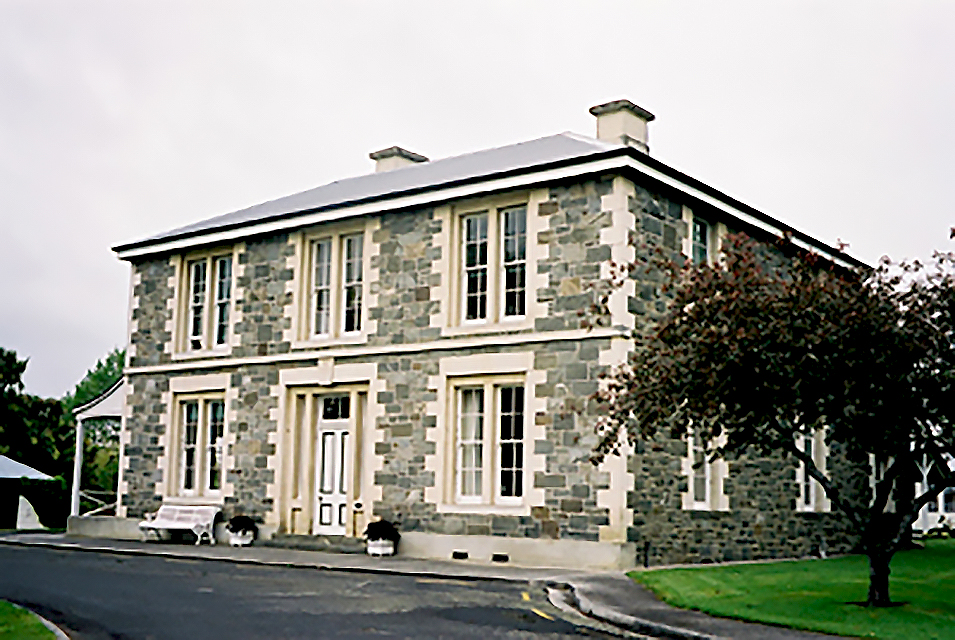This Georgian-style stone house situated at what is now the Telford Rural Polytechnic, was originally built for William Telford (1817-1888). Born in Cumberland, England, Telford immigrated to Australia in the 1840s, working his passage as a ship's carpenter. After farming in Australia for a number of years, he visited South Otago with his father-in-law in 1860 and by 1861 the family had settled in the area. Telford established both the Clifton and Otanomomo estates, while his brother Robert (?-1898) ran the hotel at Waiwera South and his father-in-law, Adam Borthwick developed the farm of Carterhope. Telford became one of the largest land owners in the area and was well known for his flock of Romney Marsh sheep and for the large-scale drainage he undertook in the area. From 1,708 sheep in 1861 Telford developed his flock to more than 18,000 by the time he died in 1888. He established his Romney Marsh stud in 1874 after purchasing 52 ewes and one ram from the estate of Mr Ludlam of Hutt, who had imported the first of the breed into New Zealand in 1853. Although originally based at Clifton, Telford moved to Otanomomo in 1867. His house, now the Administration Block for the Telford Rural Polytechnic, was erected two years later - the year of construction is carved into the keystone above the front door. It was built by David Hunter and a Mr Goodfellow. These men are variously referred to as Dunedin builders or a firm of Dunedin architects. The external walls of Telford's house were clad with basalt, quarried from Borthwick's Carterhope estate with surrounds of Oamaru stone. This combination of local basalt and Oamaru stone is common to Otago and Southland, although the Georgian style of Telford, with its hipped roof and symmetrical facades, is less so. While early Georgian-influenced houses are found dating from the early years of Pakeha settlement, such as the Treaty House at Waitangi, it was rare for them to be built in New Zealand during the nineteenth century. However, stone Georgian-style farmhouses were common in Telford's former home county, Cumberland, and it is likely his ideas of an appropriate style influenced the design of the house. Inside four rooms on the ground floor are symmetrically arranged on both sides of a central corridor with two smaller rooms located in a lean-to structure at the rear. This rear room may have been designed for use as a kitchen. However, descendant Don Telford, who stayed at the house during the 1930s remembers it being used as a classroom for the children, while the cooking was done in a separate building. At the time of his visits the verandah was partly covered in. Upstairs there are four main rooms arranged as on the ground floor and a smaller room situated above the entrance hall. A landing between the ground and upper floors provides access to a bathroom above the lean-to. All the upstairs rooms were used as bedrooms, as was one on the southwest side of the ground floor. The other three rooms downstairs were a lounge, drawing room, and dining room. The total cost of the house was said to be £3,000, and this included the use of mahogany and cedar in the interior. After Telford's death his younger son, Thomas (1863-1927), took over Otanomomo while his eldest, William (1857-1919), inherited Clifton. Thomas's son, also William (1894-1947) inherited Otanomomo in 1927. William had no children and when he died in 1947 he left the farm in trust for the purpose of improving the breeding of Romney sheep and Hereford cattle, with any additional income to go towards medical research. The government of the time declined to accept the estate on those grounds. Otanomomo continued to be run as a farm under William's trustees, but gradually declined. However, from the 1950s the local community campaigned for an agricultural training institute to be established in their area and this had a major influence on the subsequent history of Otanomomo. It was felt that a mid-way training institute was needed to provide further education for boys (exclusively at first) who wished to work on farms or to take up farms of their own, and who needed a more detailed agricultural education than they received at school, but who did not wish to take a degree at either Lincoln or Massey Universities. Improved farming conditions after the Second World War and the increased involvement of science in the process of farming, led to a call for more farm workers, and moreover, farm workers with a higher level of education. In South Otago a committee, the South Otago Agricultural Education Committee (SOAEC) was formed in 1952 to push for such an institute. SOAEC approached William's surviving sisters, Jane and Doris, about using Otanomomo for such a purpose. The sisters agreed to gift the land, stock and plant to such an institute in exchange for an annual annuity of £1,500 each. The SOAEC cause was taken up by the local Member for Parliament, J.B. (Peter) Gordon who put a Private Members Bill to Parliament in 1963. In 1964 the Telford Farm Training Institute Act was passed by Parliament and the Telford Farm Training Institute was established on the former Otanmomo estate. The Telford Farming Institute formally opened on 24 May 1965 with 11 students. Its objectives were to provide a basic training in the arts and skills of farming, as well as research into agriculture and horticulture. Telford's former homestead initially housed the first principal, Rod Snell, and his family, who cleared the surrounding garden and re-established the rose garden. From 1966 the house was transformed into a hostel for the students and by January 1967 it was full to capacity with 30 students and a warden. Bathroom and toilet facilities were built on the south side of the homestead and the former shearers' kitchen at the rear of the house was transformed into a kitchen/dining room. In 1969 a dormitory block, with space for over 60 students, was purchased from Taieri Airport and from the beginning of 1970 Telford's former homestead became the administration block of the Institute. Today the house stands on a small rise and faces a formal garden encircled by a driveway, which complements the symmetry of the building's main façade. In 1983 a further administration block to the rear was erected. This is linked to the main house by a corridor. The house is also associated with the large brick woolshed and stables, built in bricks made and fired on the property, which is also registered by the New Zealand Historic Places Trust Pouhere Taonga as a Category II historic place. The woolshed and stables building was first converted into a workshop for the Telford Institute and then to a library in 1995. Telford Training Institute was initially administered by a Board with no assistance from the government. However, in 1967 Telford received a government grant for $12,000 per year for three years and in 1974 the Institute entered into a formal partnership with the Ministry of Agriculture and Fisheries (MAF). MAF (formerly the Department of Agriculture) had been involved with agriculture training since 1920. In 1989 MAF was replaced by the Ministry of Education as part of the Labour government reforms of the 1980s and in 1991 Telford became Telford Rural Polytechnic. Today it farms 698 hectares (around 1,725 acres) divided into three units, sheep, dairy and deer, and provides training in agriculture, forestry, apiculture and more recently, the equine industry. The Telford Farm Training Institute Administration Block is a prominent landmark on the main road between Balclutha and Owaka. It was erected for a major landowner, Telford, who made a substantial contribution to the local agricultural development. The Georgian style of Telford's former homestead is particularly unusual for the era in New Zealand. The building reflects the substantial and solid place that the Telfords occupied within the local community. Since 1965 the house fulfilled various roles as part of the Telford Farm Training Institute (now Telford Rural Polytechnic), which has provided education in all aspects of farming to many New Zealanders. It is closely linked through its original owner and its subsequent history to the agricultural history of South Otago.


Location
List Entry Information
Overview
Detailed List Entry
Status
Listed
List Entry Status
Historic Place Category 1
Access
Private/No Public Access
List Number
2127
Date Entered
12th December 1990
Date of Effect
12th December 1990
City/District Council
Clutha District
Region
Otago Region
Legal description
Secs 5 and 7 Blk XXI Clutha SD (RT OT18A/824)
Stay up to date with Heritage this month
